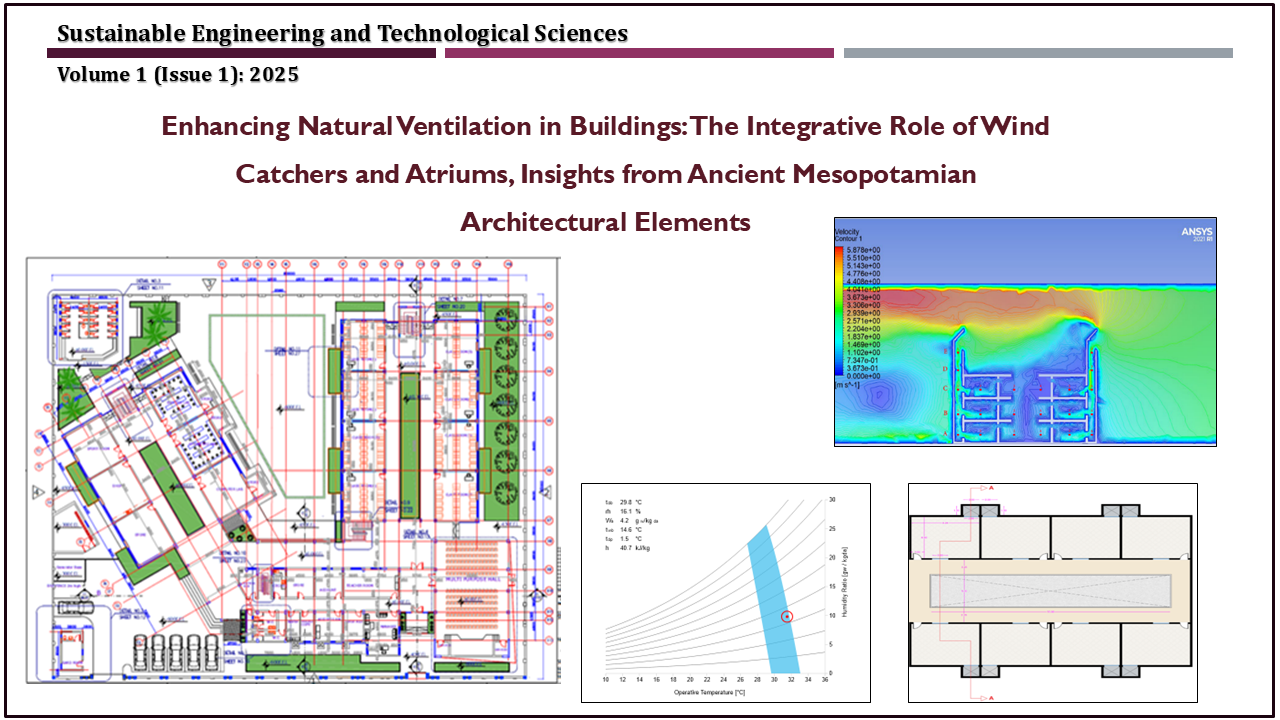Enhancing Natural Ventilation in Buildings: The Integrative Role of Wind Catchers and Atriums, Insights from Ancient Mesopotamian Architectural Elements
DOI:
https://doi.org/10.70516/778an593Keywords:
Hot dry climate, Atrium, Natural ventilation, Wind catcher, Airflow, Thermal comfortAbstract
Atriums and wind catchers are architectural design elements that have been used to improve airflow inside buildings since first civilization in Mesopotamia. Previous studies have shown the various effects of wind catchers on increasing natural ventilation in buildings in different climates. This research problem is to discover the integration role of wind catchers and atriums in enhancing natural ventilation for buildings in a hot, dry climate. A school building design in Baghdad city was chosen as a case study. A proposed wind catcher were added to the building design in addition to the exist atrium and comparison were made to various effects on natural ventilation. The results demonstrated that the integrated of the wind catchers and atrium is an efficient ventilation system that contributes to the increased airflow average speed to 2.41 m/s, The achieved air velocity can generate thermal comfort with constant climatic conditions and temperature increases up to 31.5 degrees Celsius, according to CBE Thermal Comfort Tool for ASHRAE-55 for thermal comfort building.
Downloads
References
P. S. Ghaemmaghami and M. Mahmoudi, “Passive and Low Energy Cooling 71 for the Built Environment,” 2005.
N. Benkari, I. Fazil, and A. Husain, “Design and Performance Comparison of Two Patterns of Wind-catcher for a Semi-enclosed Courtyard,” International Journal of Mechanical Engineering and Robotics Research, vol. 6, no. 5, pp. 396–400, Sep. 2017, doi: 10.18178/ijmerr.6.5.396-400. DOI: https://doi.org/10.18178/ijmerr.6.5.396-400
F. Jomehzadeh, H. M. Hussen, J. K. Calautit, P. Nejat, and M. S. Ferwati, “Natural ventilation by windcatcher (Badgir): A review on the impacts of geometry, microclimate and macroclimate,” Energy Build, vol. 226, p. 110396, Nov. 2020, doi: 10.1016/j.enbuild.2020.110396. DOI: https://doi.org/10.1016/j.enbuild.2020.110396
A. A. Elmualim and H. B. Awbi, “Wind Tunnel and CFD Investigation of the Performance of ‘Windcatcher’ Ventilation Systems,” International Journal of Ventilation, vol. 1, no. 1, pp. 53–64, Jun. 2002, doi: 10.1080/14733315.2002.11683622. DOI: https://doi.org/10.1080/14733315.2002.11683622
A. El-Shorbagy, “Design with Nature: Windcatcher as a Paradigm of Natural Ventilation Device in Buildings,” International Journal of Civil & Environmental Engineering IJCEE-IJENS Vol:10 No: 03, vol. 10, no. 3, 2010, doi: 10.1.1.226.5219.
M. H. Ghadiri, N. Lukman, N. Ibrahim, and M. F. Mohamed, “Computational Analysis of Wind-Driven Natural Ventilation in a Two Sided Rectangular Wind Catcher,” International Journal of Ventilation, vol. 12, no. 1, pp. 51–62, Jun. 2013, doi: 10.1080/14733315.2013.11684002. DOI: https://doi.org/10.1080/14733315.2013.11684002
Al-Jawadi MH, Darwish AF. The Effect of Moisturizing Treatment of Wind-Catcher on Internal Thermal Environment. 2016. DOI: https://doi.org/10.36041/iqjap.v15i1.380
Koldewey R. The Excavations at Babylon. 1914.
G. Memarian and Frank Edward Brown., “Climate, culture, and religion: Aspects of the traditional courtyard house in Iran,” J Archit Plann Res, pp. 181–198, 2003.
A. Mahyari, “The Wind Catcher A passive Cooling Device For Hot Arid Climate,” The University Of Sydney, Sydney, 1996.
A. Farhan Darwish, “The Effect of Moisturizing Treatment of Wind-Catcher on Internal Thermal Environment,” المجلة العراقیة للهندسة المعمار یة., no. 1, 2016.
Zhou J, Zhang X, Xie J, Liu J. Effects of elevated air speed on thermal comfort in hot-humid climate and the extended summer comfort zone. Energy and Buildings 2023;287:112953. https://doi.org/10.1016/j.enbuild.2023.112953. DOI: https://doi.org/10.1016/j.enbuild.2023.112953
H. Montazeri and F. Montazeri, “CFD simulation of cross-ventilation in buildings using rooftop wind-catchers: Impact of outlet openings,” Renewable Energy, vol. 118. Elsevier BV, pp. 502–520, Apr. 2018. doi: 10.1016/j.renene.2017.11.032 DOI: https://doi.org/10.1016/j.renene.2017.11.032
S. Liu, Z. Luo, K. Zhang, and J. Hang, “Natural Ventilation of a Small-Scale Road Tunnel by Wind Catchers: A CFD Simulation Study,” Atmosphere, vol. 9, no. 10. MDPI AG, p. 411, Oct. 20, 2018. doi: 10.3390/atmos9100411. DOI: https://doi.org/10.3390/atmos9100411
I. F. S. Ahmed Kabir, S. Kanagalingam, and F. Safiyullah, “Performance evaluation of air flow and thermal comfort in the room with Wind-Catcher using different CFD techniques under neutral Atmospheric Boundary Layer,” Energy Procedia, vol. 143. Elsevier BV, pp. 199–203, Dec. 2017. doi: 10.1016/j.egypro.2017.12.671. DOI: https://doi.org/10.1016/j.egypro.2017.12.671
O. Saadatian, L. C. Haw, K. Sopian, and M. Y. Sulaiman, “Review of windcatcher technologies,” Renewable and Sustainable Energy Reviews, vol. 16, no. 3. Elsevier BV, pp. 1477–1495, Apr. 2012. doi: 10.1016/j.rser.2011.11.037. DOI: https://doi.org/10.1016/j.rser.2011.11.037
P. Nejat, J. K. Calautit, M. Z. Abd. Majid, B. R. Hughes, I. Zeynali, and F. Jomehzadeh, “Evaluation of a two-sided windcatcher integrated with wing wall (as a new design) and comparison with a conventional windcatcher,” Energy and Buildings, vol. 126. Elsevier BV, pp. 287–300, Aug. 2016. doi: 10.1016/j.enbuild.2016.05.025. DOI: https://doi.org/10.1016/j.enbuild.2016.05.025
L. Moosavi, M. Zandi, M. Bidi, E. Behroozizade, and I. Kazemi, “New design for solar chimney with integrated windcatcher for space cooling and ventilation,” Building and Environment, vol. 181. Elsevier BV, p. 106785, Aug. 2020. doi: 10.1016/j.buildenv.2020.106785. DOI: https://doi.org/10.1016/j.buildenv.2020.106785
J. Foroozesh et al., “CFD modeling of the building integrated with a novel design of a one-sided wind-catcher with water spray: Focus on thermal comfort,” Sustainable Energy Technologies and Assessments, vol. 53. Elsevier BV, p. 102736, Oct. 2022. doi: 10.1016/j.seta.2022.102736. DOI: https://doi.org/10.1016/j.seta.2022.102736
A. A. Heidari and H. Eskandari, “Impact of inlet and outlet opening height variation on the air quality and ventilation efficiency in the on-top wind catcher buildings: A CFD simulation,” Science and Technology for the Built Environment. Informa UK Limited, pp. 1–19, Sep. 11, 2022. doi: 10.1080/23744731.2022.2089592. DOI: https://doi.org/10.1080/23744731.2022.2089592
Á. L. Katona, I. E. Háber, and I. Kistelegdi, “CFD Simulation Supported Development of Wind Catcher Shape Topology in a Passive Air Conduction System (PACS),” Buildings, vol. 12, no. 10. MDPI AG, p. 1583, Oct. 01, 2022. doi: 10.3390/buildings12101583. DOI: https://doi.org/10.3390/buildings12101583
S. H. Hosseini, E. Shokry, A. J. Ahmadian Hosseini, G. Ahmadi, and J. K. Calautit, “Evaluation of airflow and thermal comfort in buildings ventilated with wind catchers: Simulation of conditions in Yazd City, Iran,” Energy for Sustainable Development, vol. 35. Elsevier BV, pp. 7–24, Dec. 2016. doi: 10.1016/j.esd.2016.09.005. DOI: https://doi.org/10.1016/j.esd.2016.09.005
A. A. Dehghan, M. K. Esfeh, and M. D. Manshadi, “Natural ventilation characteristics of one-sided wind catchers: experimental and analytical evaluation,” Energy and Buildings, vol. 61. Elsevier BV, pp. 366–377, Jun. 2013. doi: 10.1016/j.enbuild.2013.02.048. . DOI: https://doi.org/10.1016/j.enbuild.2013.02.048
A. Zaki and Rajnish Sharma, “A CFD Simulation Study of Natural Ventilation with a Two-Sided Wind Catcher System,” The University of Auckland, 2017, doi: 10.17608/K6.AUCKLAND.5631109.V1.
P. Nejat, J. K. Calautit, M. Z. Abd. Majid, B. R. Hughes, I. Zeynali, and F. Jomehzadeh, “Wind tunnel and numerical data on the ventilation performance of windcatcher with wing wall,” Data in Brief, vol. 9. Elsevier BV, pp. 448–452, Dec. 2016. doi: 10.1016/j.dib.2016.09.007. DOI: https://doi.org/10.1016/j.dib.2016.09.007
M. Alwetaishi and M. Gadi, “New and innovative wind catcher designs to improve indoor air quality in buildings,” Energy and Built Environment, vol. 2, no. 4. Elsevier BV, pp. 337–344, Oct. 2021. doi: 10.1016/j.enbenv.2020.06.009. DOI: https://doi.org/10.1016/j.enbenv.2020.06.009
M. Alsailani, H. Montazeri, and A. Rezaeiha, “Towards optimal aerodynamic design of wind catchers: Impact of geometrical characteristics,” Renewable Energy, vol. 168. Elsevier BV, pp. 1344–1363, May 2021. doi: 10.1016/j.renene.2020.12.053. DOI: https://doi.org/10.1016/j.renene.2020.12.053
Y. K. Yang, M. Y. Kim, Y. W. Song, S. H. Choi, and J. C. Park, “Windcatcher Louvers to Improve Ventilation Efficiency,” Energies, vol. 13, no. 17. MDPI AG, p. 4459, Aug. 28, 2020. doi: 10.3390/en13174459. DOI: https://doi.org/10.3390/en13174459
P. Abdo, R. Taghipour, and B. P. Huynh, “Three-Dimensional Simulation of Wind-Driven Ventilation Through a Windcatcher With Different Inlet Designs,” Journal of Thermal Science and Engineering Applications, vol. 12, no. 4. ASME International, Dec. 18, 2019. doi: 10.1115/1.4045513. DOI: https://doi.org/10.1115/1.4045513
M. Liu, C. Jimenez-Bescos, and J. Calautit, “CFD investigation of a natural ventilation wind tower system with solid tube banks heat recovery for mild-cold climate,” Journal of Building Engineering, vol. 45. Elsevier BV, p. 103570, Jan. 2022. doi: 10.1016/j.jobe.2021.103570. DOI: https://doi.org/10.1016/j.jobe.2021.103570
Sarjito and T. W. B. Riyadi, “A Parametric Study of Wind Catcher Model in a Typical System of Evaporative Cooling Tower Using CFD,” Applied Mechanics and Materials, vol. 660. Trans Tech Publications, Ltd., pp. 659–663, Oct. 2014. doi: 10.4028/www.scientific.net/amm.660.659. DOI: https://doi.org/10.4028/www.scientific.net/AMM.660.659
J. K. Calautit, A. I. Aquino, S. Shahzad, D. S. N. M. Nasir, and B. R. Hughes, “Thermal Comfort and Indoor air Quality Analysis of a Low-energy Cooling Windcatcher,” Energy Procedia, vol. 105. Elsevier BV, pp. 2865–2870, May 2017. doi: 10.1016/j.egypro.2017.03.634. . DOI: https://doi.org/10.1016/j.egypro.2017.03.634
R. Taghipour, P. Abdo, and B. P. Huynh, “Effect of Wind Speed on Ventilation Flow Through a Two Dimensional Room Fitted With a Windcatcher,” Volume 7: Fluids Engineering. American Society Nov. 09, 2018. doi: 10.1115/imece2018-88666. DOI: https://doi.org/10.1115/IMECE2018-88666

Downloads
Published
Issue
Section
Categories
License
Copyright (c) 2024 Mohamed Hazim Alshakir, Susan abed Hassan (Author)

This work is licensed under a Creative Commons Attribution-NonCommercial-NoDerivatives 4.0 International License.
Open Access and Copyright: SETS operates as an open-access journal, making all its articles freely available to everyone. Published content is licensed under the Creative Commons Attribution International Public License (CC BY 4.0). This license allows individuals and organizations to:
- Download, share, distribute, and print full texts of articles
- Reproduce or link to articles in any medium,
While authors retain copyright for their published work on the SETS website, the journal actively promotes and tracks citations to increase recognition for their research.
In essence, CC-BY-4.0 encourages the widest possible dissemination and utilization of published articles as long as written permission and appropriate credit are given to the authors.







